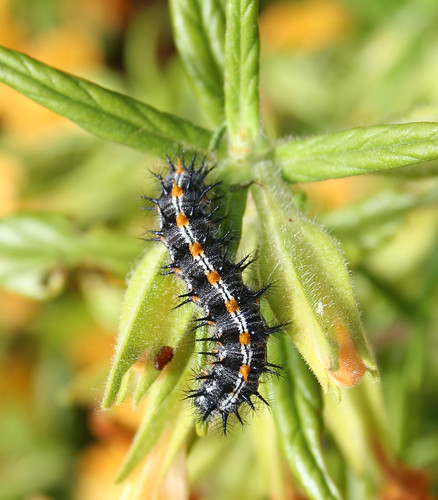Does plasticity drive speciation? Host plant shifts and diversification in nymphaline butterflies (Lepidoptera: Nymphalidae) during the tertiary
Biological Journal of the Linnean Society 94: 115-130.
Nylin, S. & Wahlberg, N. 2008
Abstract.
How and why the great diversity of phytophagous insects has evolved is not clear but, if the explanation is the diversity of plants as a resource, colonizations of novel plant taxa can be expected to be associated with higher net speciation rates. In the present study, we make use of recent advances in plant and butterfly systematics to trace the evolution of host-plant utilization in the butterfly subfamily Nymphalinae (tribes Nymphalini, Melitaeini, and the probably paraphyletic ‘Kallimini’). A clear historical pattern emerges, with an ancestral host-plant theme of ‘urticalean rosids’ and two major colonizations of novel distantly-related plant clades. The asterid order Lamiales was colonized by an ancestor of ‘Kallimini’ + Melitaeini and the family Asteraceae in Asterales was later colonized by Melitaeini butterflies. These colonization events appear to have been followed by increases in the rate of net butterfly diversification. Two not mutually exclusive scenarios to explain such patterns have been suggested: (1) adaptive radiation due to release from competition following host-plant shifts or (2) higher rates of net speciation during a relatively long-lasting potentially polyphagous (plastic) state. In support of the ‘plasticity scenario’, phylogenetic traces of a long-lasting stage with some potential to feed on more than one host-plant clade can still be seen, despite the ancient age of the colonizations. When angiosperm communities changed after the K/T boundary due to extinctions and subsequent diversification, herbivore taxa that could occupy several alternative niches may have had the greatest opportunity to diversify in turn.
Biological Journal of the Linnean Society 94: 115-130.
Nylin, S. & Wahlberg, N. 2008
Abstract.
How and why the great diversity of phytophagous insects has evolved is not clear but, if the explanation is the diversity of plants as a resource, colonizations of novel plant taxa can be expected to be associated with higher net speciation rates. In the present study, we make use of recent advances in plant and butterfly systematics to trace the evolution of host-plant utilization in the butterfly subfamily Nymphalinae (tribes Nymphalini, Melitaeini, and the probably paraphyletic ‘Kallimini’). A clear historical pattern emerges, with an ancestral host-plant theme of ‘urticalean rosids’ and two major colonizations of novel distantly-related plant clades. The asterid order Lamiales was colonized by an ancestor of ‘Kallimini’ + Melitaeini and the family Asteraceae in Asterales was later colonized by Melitaeini butterflies. These colonization events appear to have been followed by increases in the rate of net butterfly diversification. Two not mutually exclusive scenarios to explain such patterns have been suggested: (1) adaptive radiation due to release from competition following host-plant shifts or (2) higher rates of net speciation during a relatively long-lasting potentially polyphagous (plastic) state. In support of the ‘plasticity scenario’, phylogenetic traces of a long-lasting stage with some potential to feed on more than one host-plant clade can still be seen, despite the ancient age of the colonizations. When angiosperm communities changed after the K/T boundary due to extinctions and subsequent diversification, herbivore taxa that could occupy several alternative niches may have had the greatest opportunity to diversify in turn.


沒有留言:
張貼留言